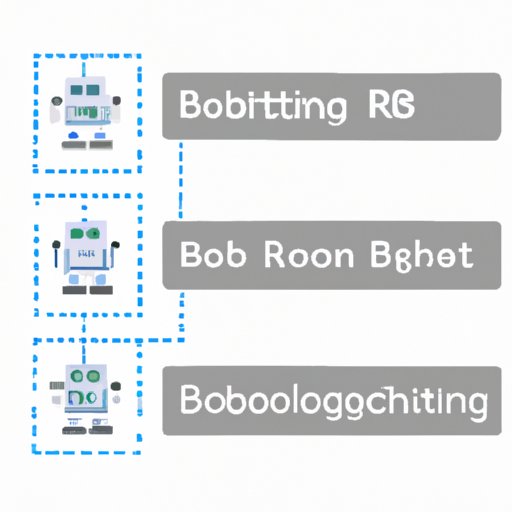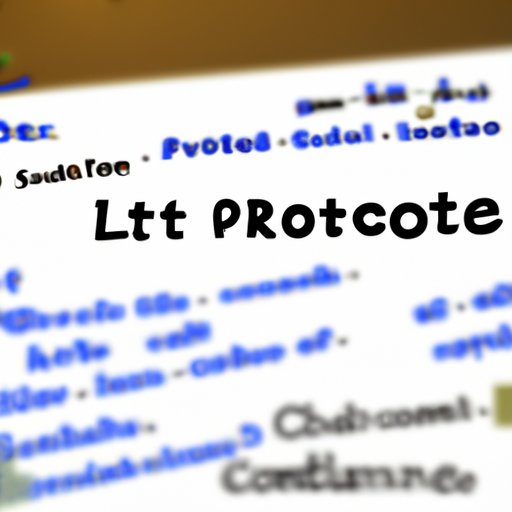Introduction
Robots have become increasingly popular in recent years, with a wide range of applications ranging from industrial automation to medical devices. But what programming language do robots use? In this article, we will explore the relationship between robotics and programming languages and provide an overview of the different programming languages used in robotics.

A. Definition of Programming Languages and Robotics
Programming languages are formal languages that allow humans to create instructions for computers and other machines. They are used to create software programs that control the behavior of a machine and to process data. Robotics is the science of designing and building robots, which are machines capable of performing tasks autonomously or semi-autonomously.
B. Exploring the Relationship Between Robotics and Programming Languages
The relationship between robotics and programming languages is a close one, as robots rely on programming languages to control their behavior and process data. Different programming languages can be used to create autonomous robots, with each language having its own advantages and disadvantages.
Body
I. An Overview of the Programming Languages Used in Robotics
There are many different programming languages that can be used to create autonomous robots, including C/C++, Java, Python, MATLAB, and Lisp. Each language has its own strengths and weaknesses, so it is important to choose the right language for the task at hand.
A. C/C++
C and C++ are two of the most popular programming languages for robotics. C is a low-level language, meaning it is closer to the hardware than other languages. This makes it ideal for controlling robots, as it allows for more precise control over the robot’s actions. C++ is an object-oriented language, meaning it is better suited for creating complex programs such as artificial intelligence algorithms.
B. Java
Java is another popular programming language for robotics. It is an object-oriented language, making it well suited for creating complex programs. It also has a large number of libraries and frameworks available, making it easier to develop robotics applications. Java is also portable, meaning it can be used on different platforms without needing to be recompiled.
C. Python
Python is a relatively new programming language that has become popular for robotics. It is an interpreted language, meaning it doesn’t need to be compiled before being executed. This makes it easy to write and debug code quickly. Python also has a large number of libraries and frameworks available, making it easier to develop robotics applications.
D. MATLAB
MATLAB is a high-level programming language used for scientific computing. It is well suited for robotics applications, as it has a wide range of tools for visualization, simulation, and analysis. MATLAB also has a large number of libraries and frameworks available, making it easier to develop robotics applications.
E. Lisp
Lisp is a high-level, functional programming language. It is often used for artificial intelligence applications, as it has powerful features for symbolic computation. Lisp also has a large number of libraries and frameworks available, making it easier to develop robotics applications.
F. Other Programming Languages
There are also a number of other programming languages that can be used for robotics, including assembly language, Prolog, and Ruby. Each language has its own advantages and disadvantages, so it is important to choose the right language for the task at hand.
II. What is the Most Common Programming Language for Robots?
The most common programming language for robots is C/C++. This is due to its low-level nature, which allows for more precise control over the robot’s actions. Java is also popular, as it is an object-oriented language and has a large number of libraries and frameworks available.
A. Popularity of C/C++ and Java
C/C++ and Java are the two most popular programming languages for robotics. This is because they are both low-level and object-oriented languages, making them well suited for controlling robots and creating complex programs such as artificial intelligence algorithms.
B. Advantages of Using C/C++ and Java
C/C++ and Java have a number of advantages when it comes to robotics. Both languages are low-level and object-oriented, making them well suited for controlling robots and creating complex programs. They also have a large number of libraries and frameworks available, making it easier to develop robotics applications.

III. How Different Programming Languages are Used to Create Autonomous Robots
Different programming languages can be used to create autonomous robots, depending on the task at hand. C/C++ and Java are often used for controlling robots, as they are low-level and object-oriented languages. Python is often used for artificial intelligence applications, as it is an interpreted language and has a large number of libraries and frameworks available. MATLAB is also popular for robotics, as it has a wide range of tools for visualization, simulation, and analysis.
IV. The Pros and Cons of Different Programming Languages for Robotics
Each programming language has its own advantages and disadvantages when it comes to robotics. C/C++ and Java are low-level and object-oriented, making them well suited for controlling robots and creating complex programs. Python is an interpreted language, making it easy to write and debug code quickly. MATLAB has a wide range of tools for visualization, simulation, and analysis. Lisp is often used for artificial intelligence applications, as it has powerful features for symbolic computation.
Conclusion
In conclusion, there are a number of different programming languages that can be used to create autonomous robots. C/C++ and Java are the two most popular languages, as they are low-level and object-oriented. Python is often used for artificial intelligence applications, as it is an interpreted language and has a large number of libraries and frameworks available. MATLAB is also popular for robotics, as it has a wide range of tools for visualization, simulation, and analysis. Finally, Lisp is often used for artificial intelligence applications, as it has powerful features for symbolic computation.

of the Different Programming Languages Used in Robotics
In this article, we explored the relationship between robotics and programming languages. We provided an overview of the different programming languages used in robotics, including C/C++, Java, Python, MATLAB, and Lisp. We discussed the advantages and disadvantages of each language and how they can be used to create autonomous robots.

B. Recommendations on Which Programming Language to Use for Robotics
When choosing a programming language for robotics, it is important to consider the task at hand. C/C++ and Java are often used for controlling robots, as they are low-level and object-oriented languages. Python is often used for artificial intelligence applications, as it is an interpreted language and has a large number of libraries and frameworks available. MATLAB is also popular for robotics, as it has a wide range of tools for visualization, simulation, and analysis. Lisp is often used for artificial intelligence applications, as it has powerful features for symbolic computation.
C. Final Thoughts on Programming Languages and Robotics
Robots rely on programming languages to control their behavior and process data. Different programming languages can be used to create autonomous robots, with each language having its own advantages and disadvantages. When choosing a programming language for robotics, it is important to consider the task at hand and choose the language that best suits the application.
(Note: Is this article not meeting your expectations? Do you have knowledge or insights to share? Unlock new opportunities and expand your reach by joining our authors team. Click Registration to join us and share your expertise with our readers.)
